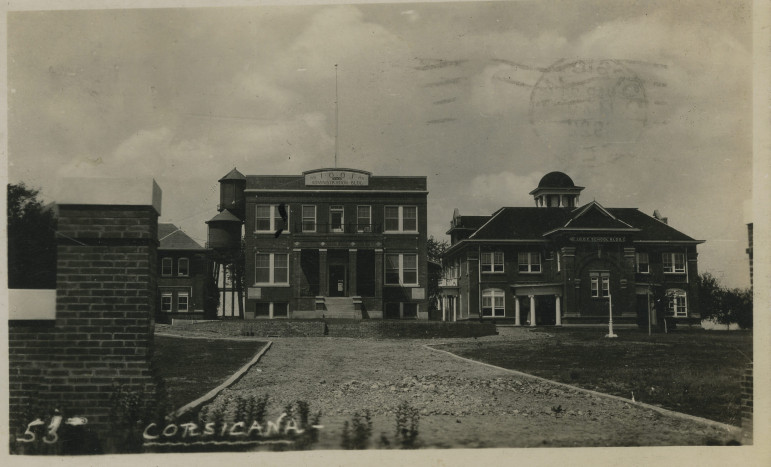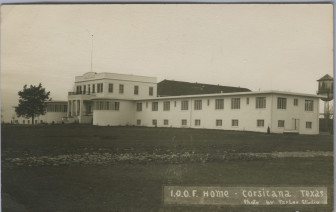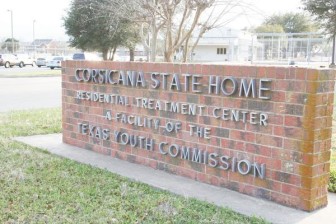
Archival image of the Corsicana youth detention facility" credit="
This story was also published by the Center for Public Integrity and the Texas Tribune.
When the Texas Juvenile Justice Department released a report in June 2013 recommending the closure of the Corsicana Residential Treatment Facility, situated in the small city of Corsicana, Texas, 55 miles south of Dallas, the authors presented an arresting image. The campus, they wrote, “continues to pose a risk to the vulnerable youth population it serves as hazardous debris and glass are continually unearthed after rain or strong winds.” The roughly 90 youths at the facility, most of whom had been diagnosed with severe mental illnesses and who had committed crimes, were using the glass and debris to "harm themselves." Many of the buildings, the authors noted, "warrant complete replacement."
When Corsicana was finally emptied by the Texas Legislature in December 2013, many in the world of juvenile justice reform already viewed the facility as dangerous and unsalvageable. A federal Bureau of Justice Statistics report found that in 2008, 23 percent of Corsicana inmates reported having had sexual relations with staff. Violence was up as well; in 2012, the facility was responsible for 32 percent of all violent incidents in the juvenile justice agency, despite housing only 10 percent of the agency’s youths.
Thanks to support from donors like you and major foundations, we are able to make our stories available to audiences well beyond the JJIE.org's website. Today this story is also running at the Texas Tribune and the Center for Public Integrity.
It hadn't always been this way. The “hazardous debris and glass” had once belonged to a pristine set of buildings where for decades the state’s orphans had received a free education and learned vocational skills while churning butter, eating pork chops and rotating various household chores.
Over the last 124 years, ever since it was founded by an 1887 bill in the Texas Legislature as the Texas Orphan Asylum, this facility’s particular history has followed broader trends in juvenile issues. As the nation turned to incarceration, the facility grew, only to shrink as the country turned back to community programs. The abuses found at Corsicana could be found in many other places across the United States. But so could the positive stories, as agencies clambered to respond to federal scrutiny. As the country changed, and its approach to juvenile justice changed, so did Corsicana, mirroring the country's treatment of its youngest and most vulnerable population.
When the facility opened in 1889, it housed 54 orphans and dependent children on a 200-acre campus of tree lined walkways and grand brick buildings. The numbers grew quickly: 400 by the turn of the century, 890 as the Great Depression began in 1932.
“People couldn’t take care of their children and they’d just leave them,” explained Dr. Tommy Stringer, a local historian and an administrator at Navarro College. “Sometimes they’d come back and sometimes they didn’t.”
The numbers dropped again in the 1940s, but according to records studied by historians James Markham and William T. Field, in 1948 the facility had “twenty-one brick structures and a number of small frame cottages, barns, and outbuildings on 417 acres.” The home operated as its own independent school district, and taught youths vocational skills ranging from cosmetology to mechanics to printing to agriculture. The youths helped operate a broom factory, sorghum mill, farm, dairy, laundry, cannery, store, power plant, bakery, kitchen and hospital.

Archival image of the Corsicana youth detention facility" credit="
Robert Calvert, who later became the chief justice of the Texas Supreme Court, lived at Corsicana after his father died and his mother, who couldn’t care for him, dropped him off one day. Calvert was 7 years old. In a 1972 oral history interview with Baylor University, he remembered that kids taken to the home spent a couple of weeks in quarantine. Once out, they were put in a chore rotation. Calvert chopped wood for the kitchen’s wood-burning stove. He churned butter. And for more than a year he tended to the hogs, on one occasion delivering a sow’s babies. “I’m probably one of the few people in the world that was ever midwife to a sow,” he said with a laugh.
Agnes Johns, who was dropped off by her parents in 1942 and graduated from the facility’s high school in 1951, told JJIE she remembers sweeping the floors, and polishing them by having one girl stand on a wool blanket while another dragged her along. “The facility just made a lot of memories,” she says. Sixty years later, Johns still remembers the pork chops: “The best pork chops I ever had in my life.”
In those days, most of the youths housed at Corsicana were from nearby counties, and the facility was not a part of the Texas juvenile justice system. That system was centered in Gatesville, about 100 miles away, where in the late 1880s the Texas Legislature oversaw the construction of a “House of Correction” for juvenile male offenders, who were seen for the first time as needing an institution separate from the ones housing adults.
While Corsicana’s kids — all of them white — were farming and taking classes, juvenile lockups were expanding, largely along racial lines.
While Corsicana’s kids — all of them white — were farming and taking classes, juvenile lockups were expanding, largely along racial lines. In Texas and nationally, “white reformers did not include black children in the emerging idea of modern childhood,” explains Dr. William Bush in his 2010 book, “Who Gets a Childhood: Race and Juvenile Justice in Twentieth Century Texas.”
He writes: “Juvenile courts and institutions discriminated against African Americans by allocating fewer resources for their treatment, which had the effect of narrowing the range of options to punitive ones such as incarceration.” Like their adult counterparts, juvenile offenders received little in the way of education programs and worked brutal farm jobs.
The parallel tracks of state care for youth converged in 1957, when a reorganization brought orphanages and juvenile facilities under the same agency, the Texas Youth Council. The merger signaled a turn toward community-based treatment plans for juvenile offenders, as well as the increased use of foster care for state dependents. Students at the orphanage were transferred to the Corsicana Independent School District and the facility became known as the Corsicana State Home.
Nationally, juvenile courts were soon forced by the U.S. Supreme Court — in Kent v. U.S. and In Re Gault — to recognize due process rights not unlike those of adults, including notification of charges, protection against self-incrimination, the right to counsel and the right to confront witnesses. The largest reforms in Texas came with the 1971 case Morales v. Turman, in which Judge William Wayne Justice oversaw massive changes in the treatment of juvenile offenders. There would be no more corporal punishment or extended isolation. All juvenile facilities would be run with a common set of standards. Responding to the case, the Texas Legislature considered shifting toward community programs and other alternatives to confinement.
There would be no more corporal punishment or extended isolation.Although Corsicana still housed non-delinquent, state-dependent children throughout the 1960s and 1970s, the broader trend toward community-based treatment brought on by these changes was mirrored in increased usage of foster care for state-dependent children who would have once filled Corsicana. Texas was following national trends, and with this shift, the facility needed a new mission, a new population on which to focus its resources.
In 1983, the facility became a residential treatment center for emotionally disturbed youth, or what one internal report referred to as “‘hard to place’ adolescents.” That year the Texas Youth Council became the Texas Youth Commission (TYC), and though the facility had a new mission, it did not yet have enough youth to actually fulfill its design.
It didn’t take long. With the erosion of social welfare programs under President Ronald Reagan, the country, and Texas, saw a massive spike in violent youth crime. According to an official TYC history, “the Texas rate for homicides by juveniles was almost twice the national rate … and there was a 285 percent increase in youth committed to TYC for violent offenses.” Texas authorities enacted “blended sentencing,” allowing a juvenile offender to enter adult facilities once they turned 18.
The country at large and Texas in particular were demanding that violent youths be locked up in the interest of public safety.Reflecting the boom in incarceration brought on by the national War on Drugs and criminologist John DiIulio’s popular conception of the juvenile “super-predator,” the country at large and Texas in particular were demanding that violent youths be locked up in the interest of public safety. Critics, according to Bush, the historian, “decried” the term “for fanning the flames of an already extant panic that had caused many state legislatures to pass tougher juvenile sentencing laws.”
By the late 1990s, the numbers resulting from this swing toward fear were simply unmanageable, and Corsicana, equipped to hold roughly 100 youths, overflowed. Large numbers of youths throughout the bulging juvenile justice system were diagnosed with mental illnesses, and most of them were in facilities not explicitly designed or equipped to handle them. TYC had trouble finding and keeping trained staff to look after the statewide locked up juvenile population, which by 2001 had reached more than 5,000. Something would have to give.
In 2007, reporter Nate Blakeslee published a landmark article in The Texas Observer outlining sexual misconduct by administrators at the West Texas State School, near Odessa, and the cover-up by Texas Youth Commission authorities. Investigations by the Texas Rangers, the FBI and other media found that sexual and violent conduct had been condoned to a shocking degree throughout the system, including some 2,000 allegations of staff-on-youth violence between 2003 and 2006 and 60 instances of “suspicious broken bones,” according to a report issued by the 2007 legislature's "Joint Select Committee on the Operation and Management of the Texas Youth Commission."
Further investigations found that Corsicana had played a major role in the scandal. In 2008, according to U.S. Bureau of Justice Statistics, 23 percent of Corsicana inmates said they’d had sexual relations with staff.
In another Texas Observer report, by journalist Laura Burke, TYC administrators countered that numerous inmates would make false allegations in order to speak to a psychologist about other issues, or so they could go get a sexual assault exam and “eat hamburgers and cookies.” Corsicana Superintendent Laura Braly also explained that since so many of the Corsicana inmates had mental illnesses and had been sexually victimized since early ages, they were more likely to “interpret everything as being sexual.”
Even still, the agency enacted reforms. In 2010, TYC executive director Cherie Townsend testified to the U.S. Department of Justice’s Review Panel on Prison Rape that Corsicana was trying to improve safety and had “strengthened treatment,” “increased professional development,” “implemented ‘Seeking Safety’ curriculum” and “sealed bathroom doors that are not in use.” TYC facilities were outfitted with more than 10,000 cameras.
“If I'm watching video footage and I see a staff member maybe touch a kid on the arm too much, proximity is maybe too close,” Braly told the panel at a hearing. “That's a red flag for me, and that's something we're going to watch.” Braly instituted town hall meetings among the staff and more intensive screenings for incoming youths.
Those reforms had uneven success. According to data obtained from the Texas Department of Juvenile Justice by The Texas Tribune, Corsicana’s rate of staff-on-youth violence dropped just as “confirmed physical assaults among youths” steadily grew from 17 assaults per 100 youth in 2007 to 54 in 2011. “The Corsicana Residential Treatment Center for youth with serious mental illness has, by far, the highest levels of violent and disruptive behavior in [the Texas Juvenile Justice Department],” wrote Dr. Michele Deitch, a senior lecturer at the University of Texas LBJ School for Public Affairs, in a May 2013 report called “Understanding and Addressing Youth Violence in the Texas Juvenile Justice Department.” “This calls into question not only the safety of youth in the facility but also the effectiveness of the programming taking place there and the appropriateness of this setting for a treatment purpose.”
Although journalists were not allowed to interview inmates and staff, Brandi Grissom spoke with the mother of one Corsicana inmate who had been stabbed twice during his three and a half years there. Other youths stole his food, and the staff did not intervene.
“Corsicana was stymied from the start,” Deitch explains. “There were so many factors” that made the Corsicana facility “not very effective,” including the fact that it was far from an urban center, where more mental health specialists could be called upon, and the fact that “it was an old, rundown place.”
In the wake of the agency-wide scandals, legislators, urged by activists and think tanks, oversaw a shift from large juvenile lockups to the increased use of community-based treatment and rehabilitation programs. These programs focus on keeping juvenile offenders closer to their home communities and in smaller groups. The Corsicana facility had once housed 200 youths, but by 2013 had fewer than 70, and this reflected a statewide decline from nearly 5,000 youths in state-run lockups to roughly 1,200, according to statistics published by the Austin American-Statesman.
As the Legislature increasingly listened to reformers and looked to put more troubled youths in small, community-based programs, it decided that the state could no longer afford to keep open all of its juvenile facilities. Corsicana, with its aging buildings and high rates of violence, was at the top of the list. Local state Rep. Byron Cook argued vehemently to keep the campus open, in part because of the jobs it provided.
In that sense, Corsicana was no different than hundreds of other prisons in rural areas around the country that provide employment for the local population. Those jobs can be hard to replace in such small communities. But in Corsicana, according to Dr. Stringer, the nature of working with mentally ill youths meant that those employed at the institution were particularly committed to their work. “They’d given a lot to that facility,” he said.
At the end of 2013, the youths formerly housed there were transferred to other facilities. It’s being kept open with a skeleton staff, and closure, to many, seems imminent. Deitch and other juvenile justice advocates worry about what will happen to the youths who once populated it. “The real problem is that they don't know what to do with this population,” she says, “and they didn't solve the problem by closing this facility.”
“These kids need to be handled not out in the free world, but in a very different environment than in a correctional setting, a setting more like a hospital than a juvenile prison,” she added.
When the possibility of closure was announced, adults who had once lived at the facility as state-dependent children, and who still hold yearly reunions at the facility’s grounds, objected. They reminded lawmakers that the facility had historical relevance, transcending contemporary policy concerns. “To us it’s hallowed ground,” said Johns, the alumnus. “If they wait a few years, we’ll all be gone and they can do whatever they want.”
Maurice Chammah is a freelance writer in Austin, Texas, whose work has appeared in The New York Times, Texas Monthly, Guernica Magazine, The Texas Observer, and elsewhere. Read more of his writing at www.mauricechammah.com.
This story was also published by the Center for Public Integrity and the Texas Tribune.


